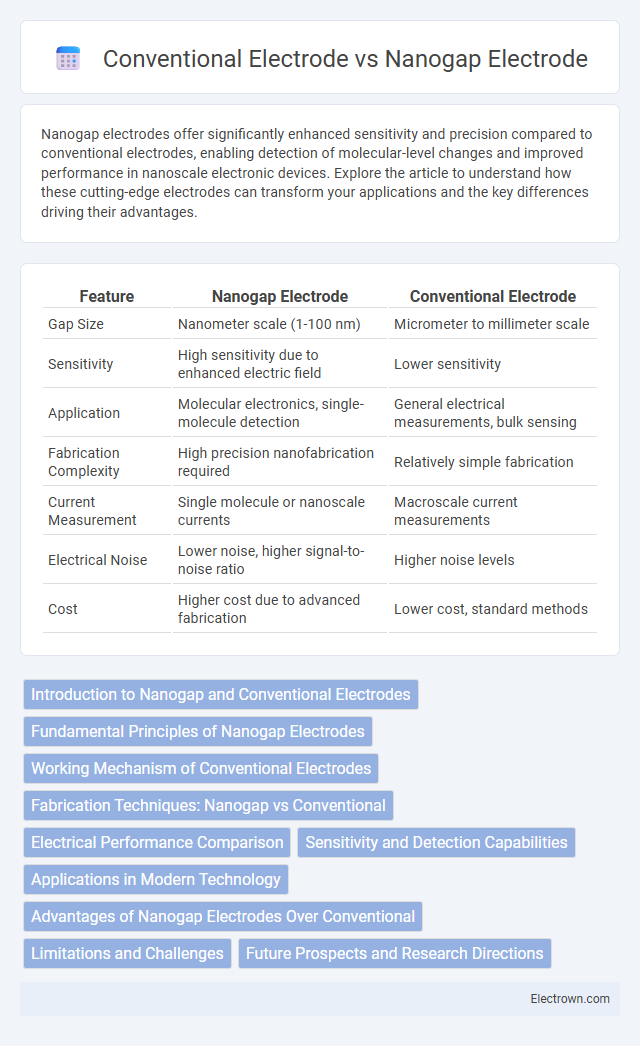Nanogap electrodes offer significantly enhanced sensitivity and precision compared to conventional electrodes, enabling detection of molecular-level changes and improved performance in nanoscale electronic devices. Explore the article to understand how these cutting-edge electrodes can transform your applications and the key differences driving their advantages.
Table of Comparison
| Feature | Nanogap Electrode | Conventional Electrode |
|---|---|---|
| Gap Size | Nanometer scale (1-100 nm) | Micrometer to millimeter scale |
| Sensitivity | High sensitivity due to enhanced electric field | Lower sensitivity |
| Application | Molecular electronics, single-molecule detection | General electrical measurements, bulk sensing |
| Fabrication Complexity | High precision nanofabrication required | Relatively simple fabrication |
| Current Measurement | Single molecule or nanoscale currents | Macroscale current measurements |
| Electrical Noise | Lower noise, higher signal-to-noise ratio | Higher noise levels |
| Cost | Higher cost due to advanced fabrication | Lower cost, standard methods |
Introduction to Nanogap and Conventional Electrodes
Nanogap electrodes feature electrode pairs separated by nanoscale gaps, typically less than 100 nanometers, enabling quantum effects and highly sensitive detection at the molecular level. Conventional electrodes, with micrometer or larger separations, rely on bulk electrical conduction and are widely used in macro-scale applications like batteries and sensors. The unique nanogap structure offers enhanced electrical field concentration and tunneling phenomena, distinguishing it from the more traditional conduction mechanisms found in conventional electrodes.
Fundamental Principles of Nanogap Electrodes
Nanogap electrodes operate on the principle of creating an electrode gap on the nanometer scale, enabling precise control of electron tunneling and enhanced sensitivity in detecting molecular interactions. Unlike conventional electrodes with micron-scale gaps, nanogap electrodes leverage quantum effects and significantly improved electric field localization to facilitate single-molecule measurements and nanoelectronics applications. This fundamental difference allows nanogap electrodes to achieve unprecedented resolution and performance in nanoscale sensing and device fabrication.
Working Mechanism of Conventional Electrodes
Conventional electrodes operate by facilitating electron transfer through a relatively large contact area between the electrode surface and the analyte, which relies on bulk conduction and diffusion processes. These electrodes typically use materials such as gold, platinum, or carbon, enabling redox reactions that generate measurable electrical signals. Your analysis with conventional electrodes depends on their ability to provide stable, reproducible current responses through well-established electrochemical interfaces.
Fabrication Techniques: Nanogap vs Conventional
Nanogap electrode fabrication involves advanced techniques such as electron beam lithography, focused ion beam milling, and controlled electromigration to achieve electrode separations on the nanometer scale, enabling high-resolution electrical measurements. Conventional electrode fabrication typically employs photolithography and mechanical cutting methods, resulting in micrometer-scale gaps with less precision. Your choice between these techniques affects device sensitivity and integration capabilities in nanoelectronic applications.
Electrical Performance Comparison
Nanogap electrodes exhibit significantly enhanced electrical performance compared to conventional electrodes due to their nanoscale spacing, enabling higher electric field intensities and improved charge carrier transport. The reduced electrode gap in nanogap configurations lowers the contact resistance and increases the sensitivity for detecting electrical signals at the molecular or nanoscale level. Conventional electrodes, with micrometer-scale gaps, suffer from higher resistance and lower field concentration, limiting their efficiency in applications requiring ultra-high precision and responsiveness.
Sensitivity and Detection Capabilities
Nanogap electrodes exhibit significantly higher sensitivity and detection capabilities compared to conventional electrodes due to their nanoscale gap size, which allows for enhanced electron tunneling and localized electric field effects. This results in improved signal-to-noise ratios and the ability to detect low-concentration analytes with greater precision. Your analytical measurements benefit from these advancements, enabling more accurate and reliable detection in various sensing applications.
Applications in Modern Technology
Nanogap electrodes enable ultra-sensitive detection and precise electrical measurements at the molecular level, revolutionizing biosensors and nanoelectronics design. Conventional electrodes remain essential for high-current applications like power supplies and large-scale circuitry but lack the spatial resolution needed for nanoscale devices. Your integration of nanogap electrodes enhances device miniaturization and performance in cutting-edge fields such as molecular diagnostics and quantum computing.
Advantages of Nanogap Electrodes Over Conventional
Nanogap electrodes offer significantly enhanced sensitivity and spatial resolution compared to conventional electrodes, enabling precise detection of nanoscale electrical signals. Their reduced electrode spacing minimizes noise and improves signal-to-noise ratio, facilitating the study of single molecules or nanoparticles with exceptional accuracy. Your experiments benefit from faster electron transfer rates and greater electrochemical stability when using nanogap electrodes, making them ideal for advanced applications in biosensing and nanoelectronics.
Limitations and Challenges
Nanogap electrodes face significant challenges including fabrication complexity at the nanoscale, which limits mass production and device consistency. Conventional electrodes, while easier to manufacture, suffer from lower sensitivity and resolution when detecting molecular-scale signals. You must weigh the trade-offs between the precision of nanogap electrodes and the scalability of conventional electrodes based on your specific application needs.
Future Prospects and Research Directions
Nanogap electrodes offer unprecedented sensitivity and spatial resolution compared to conventional electrodes, making them ideal for next-generation nanoelectronic and biosensing devices. Research is increasingly focused on integrating nanogap technology with advanced materials like graphene and exploring quantum effects at the nanoscale to enhance device performance. Your ability to leverage these innovations will be crucial in developing ultra-precise sensors and transistors for future applications in healthcare, environmental monitoring, and quantum computing.
Nanogap Electrode vs Conventional Electrode Infographic

 electrown.com
electrown.com